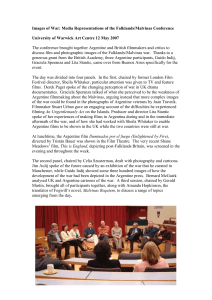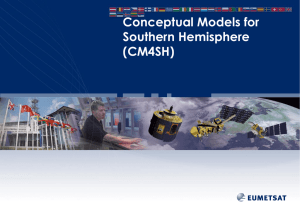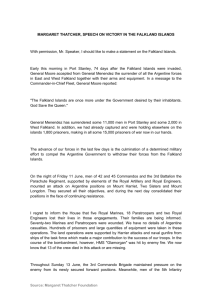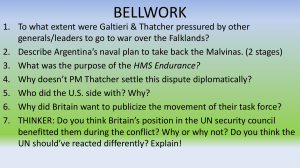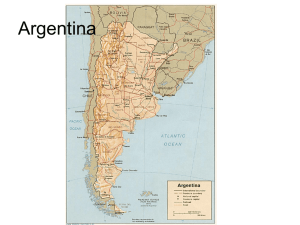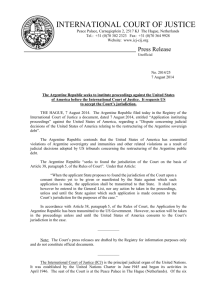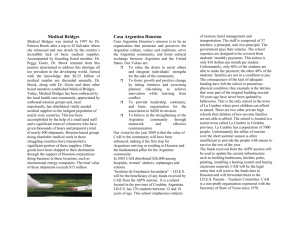The Falkland War - Personal.psu.edu
advertisement
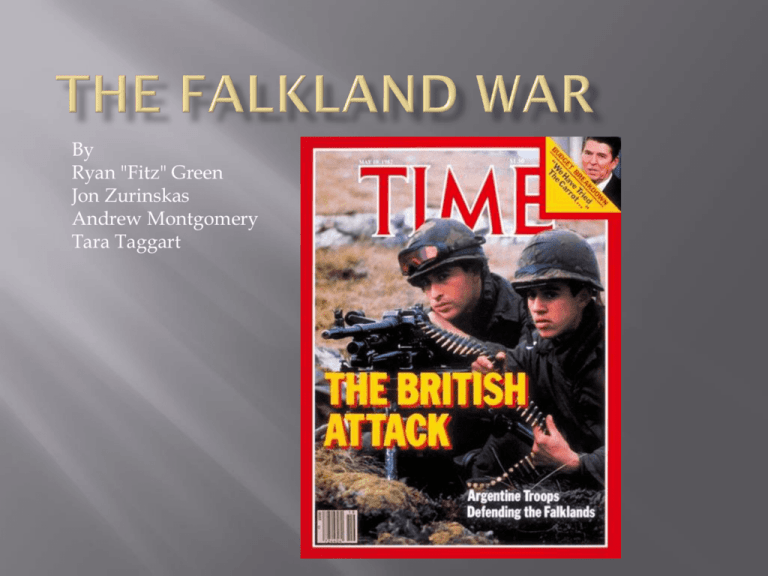
By Ryan "Fitz" Green Jon Zurinskas Andrew Montgomery Tara Taggart Also known as the Malvinas Islands Almost 300 miles from Argentine mainland Capital: Stanley Two main islands West and East Falkland Hundreds of small islands Population: 3,140 Colonial period Claims by Britain, Spain and France Post-Colonial period Napoleonic Wars liberated Argentina Argentina made claims, settlers expelled by British 1833 British power on the decline However, British still believe in self-determination Decolonization is gaining momentum Population clearly in favor of staying British possession Argentine government tries coercive diplomacy 1976 Fails, government becomes impatient New leaders come to forefront of the Junta General Leopoldo Galtieri Admiral Jorge Anaya Brigadier Basilio Lami Dozo Possible causes of the war Popular domestic unrest Misperceptions of motivations Growth of Argentine military Decline of British power Argentine troops set up flag on South Georgia Seen as first event of Falklands war Argentina invades the Islands April 2, 1982 Formal Declaration of War about a month later • April 2nd 1982 Argentina launches an amphibious landing on the Falkland Island • Argentine Marines quickly seized the capital of the Falklands, Port Stanley. • The small garrison of marines were largely outnumbered, and forced to surrender to Argentine forces. • The following day the island of South Georgia was invaded. • After a brief firefight, the small presence of Royal marines were forced to surrender to Argentine forces Prime Minister Margaret Thatcher ordered the assembly of naval task force to retake the island. In mid April Admiral Sir John Fieldhouse began moving south On April 25th British forces recaptured South Georgia Island after sinking a Argentine Submarine. Shortly after RAF bombers began bombing Argentine controlled airfields and radar towers. May 2nd, HMS Conqueror sank ARA Belgrano, killing 323 and capturing over 700 seamen May 4th A successful missile strike claimed HMS Sheffield killing 20 crew members May 21st British Amphibious Task group mounted operation Sutton, this led to the British securing a beachhead at Port San Carlos to conduct offensive operations. On the same day HMS Ardent was sunk followed by HMS Antelope on the 24th and HMS Coventry on the 25th. Early on May 27th British forces attacked Darwin and Goose Green which was occupied by Argentine Infantry forces. After a grueling two day battle British forces pushed the Argentine forces back.The result was 961 Argentine forces were captured. Meanwhile British Commando’s and SAS were moved onto Mount Kent. They met resistance from Argentine Commando’s. On May 31st after waging an intense hit and run battle British forces defeated the Argentine Commando’s at the Battle of Top Malo House. June 1st 5000 British troops arrived to attack Port Stanley British ships were attacked and badly damaged by Argentine bombers. BBC television recorded this happening, which were seen around the world. June 11 1982 – British launch as brigade sized attack against high grounds surrounding Stanley. The battles of Mount Harriet, Two Sisters and Mount Longdon resulted, followed by the Battle of Wireless Ridge and Mount Tumbledown British Victory at Mount Tumbledown, last line of natural defense. Argentine forces in Stanley became worried. June 14th General Menendez surrendered to MG Jeremy Moore June 20th British retook S. Sandwich Islands and declared an end to hostilities British British Army - 122 Royal Navy - 87 Royal Marines - 26 Merchant Navy - 9 Royal Fleet Auxiliary - 7 Falkland Islanders - 3 Royal Air Force - 1 Total 255 Total wounded - 777 Argentines Navy - 392 (323 in ARA Belgrano, rest most marines) Army - 179 (11 officers, 30 sc, 138 conscripts) Air Force - 55 (36 pilots) Gendarmeria (border guard) - 7 Prefectura (coast guard) - 2 Total 635 Total wounded - 1068 U.S. Treaty Obligations NATO Inter-American Treaty of Reciprocal Assistance Debate Mediation Secretary of State, Alexander Haig Intelligence Information Military equipment U.S. Secretary of Defense, Caspar Weinberger Built by U.S. task force during World War II Re-opened in 1957 Used as staging base for RAF during Falklands War Reagan and Weinberger both awarded Knight Commander of British Empire September 2001-Vicente Fox End of the War •June 14, 1982- Commander agrees to cease fire and 9,800 argentine troops dropped their weapons •British Major Jeremy Moore flew into Port Stanley to meet with General Menendez •Menendez is allowed to strike “unconditional” from surrender document – His surrender would be with “dignity and honor” according to British podcasts •General Moore does not allow him to insert the Argentina propaganda “Las Malvinas” after “Falklands” •Document was formally signed and the war is over. War Results •War lasted 72 days and claimed the lives of 236 British and 655 Argentine Troops •War cost of at least $2 billion •9,800 Argentine troops were made POWS and were repatriated to Argentina on liner Canberra •June 25- Governor Rex Hunt returns as Commissioner of the Falklands at Stanley •British Government decreed all classified information would be available to public in 2002. War Results •War helped revive and reelect Margaret Thatcher –1990, she supplied the backbone to George Bush and urged him to take military action when Iraq invaded Kuwait •Defeat severely discredited the military government and forced the resignation of Leopoldo Galtieri –This paved the way for restoration of democracy in Argentina –Elections were held in October 1983 •Falkland war is made a public holiday in Argetina called: “Dia del Veterano de Guerra y los Caidos en Malvinas” Military Analysis •Naval battle after WWII proved vulnerability of surface-ships to anti-ship missiles •Reaffirmed effectiveness of aircraft in naval warfare and re-emphasized the importance of total air supremacy. •Missiles proved lethality so ships used close-in weapons system (CIWS) •UK decided to build Harrier Aircraft- can operate from forward bases with no runways Britain’s Tactical Errors •British Ministry of Defense had been accused of failing to prepare service personnel for war and for care afterwards –Ignored issue of PTSD •More veterans have committed suicide since the Falkland War ended than the number of troops killed in action Argentina’s Tactical errors •Britain had spread disinformation that their hunter-killer subs were deployed in number and this failed to be true, but the Argentinians believed the reports •The army did not use their troops effectively, majority stayed near Port Stanley Political Analysis •War illustrates role of political miscalculation and miscommunication –Both sides underestimated the importance of the Falklands to the other •Since the UK is an integral U.S. ally and important part of NATO, to permit a loss would have been a signal to the USSR that the NATO alliance was militarily and politically weak. •Victory was not over-looked by USSR and they increased troop levels facing the British Army of the Rhine Falkland Islands Today •Economic prosperity and modernization through establishment of fisheries regime •Offshore oil exploration, onshore mineral prospects are ongoing processes •Tourism is expanding quickly, especially from expedition ships •an international airport, an all-purpose jetty, the creation of a development corporation and more have all been accomplished •Now an overseas territory of the UK and a member of the Commonwealth family Questions • What were the causes of the Falkland Wars? • Why did the Argentine general surrender so quickly? • Did the U.S. make the correct choice in supporting the U.K.?
